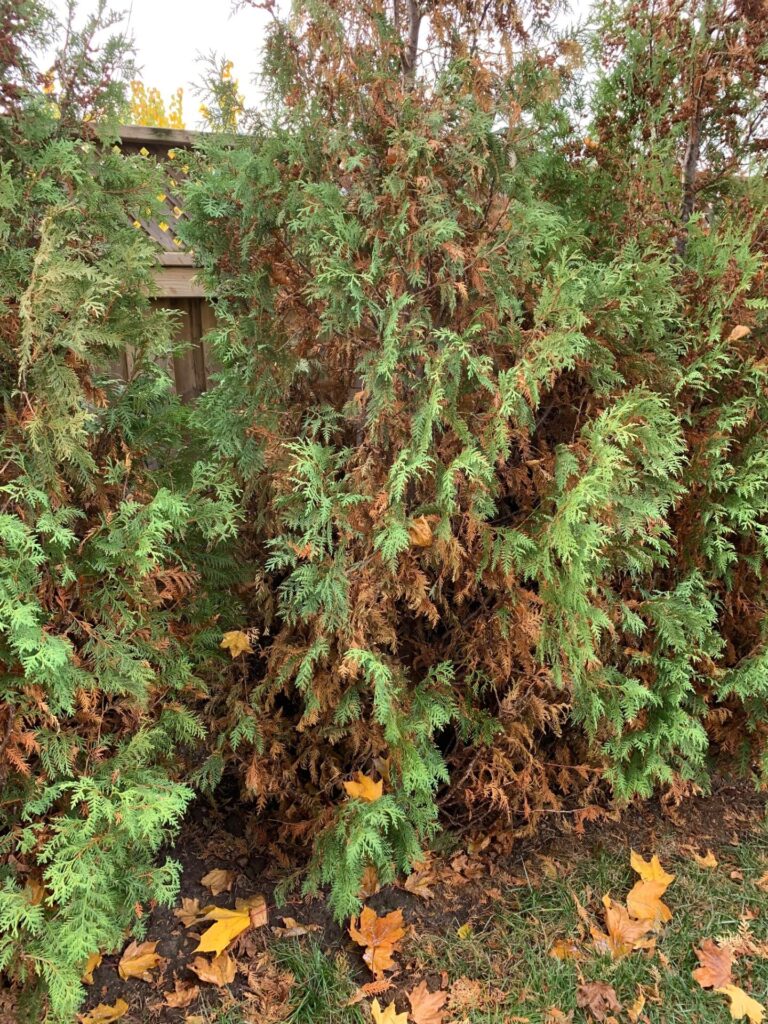
Hello,
In May of this year, I had a line of 10 feet cedars put in at my house. I live in Toronto, the ground is clay. There is some blockage of sun from a tree nearby.
My cedars have grown well in height since, but over the last couple of months, some of them have been showing signs that make me worried about their health.
Perhaps it is just transplant shock but I was wondering if you had any suggestions about what might be causing this discolouration. I water them regularly and recently put in nutrient spikes (near the ones that are looking in rough shape). I don’t believe they have spider mites as I looked for that too
Your expertise would be very helpful!
You are not alone in wondering why your cedars are browning. We get this question a lot as it is a common occurrence at this time of year. It sounds like you have done some research yourself in checking that they have had adequate water and for any visible signs of insect infestation. Here are a couple of thoughts of what could be causing the discolouration of their foliage.
As mentioned in previous answers regarding browning cedars, white cedars also known as Thuja occidentalis, have a love of water. Too much can cause the roots to rot and too little can cause severe plant stress. Both these situations can lead to browning and leaf drop. It sounds like you have been watering regularly since their installation in May. We did, however have a very hot summer which can cause stress to cedars. One thing you can try doing is digging down about 6 inches below the soil surface to see if there is moisture at this level. I would recommend continuing your watering schedule right up until the first frost. In the spring, if you are not already using one, try watering with a soaker hose as this waters right at root level and is the most efficient in preventing water loss from evaporation.
The other reason that your cedars are browning is most likely due to their natural leaf shed. I often tell people that the term “evergreen” is a bit of a misnomer as all trees and shrubs have a shedding period of their old growth. According to Iowa State University’s Horticultural Extension, “the browning of the inner foliage is probably due to seasonal needle drop. It’s normal for evergreens (pine, spruce, fir, juniper, arborvitae, etc.) to shed their oldest (innermost) needles in fall. The innermost needles gradually turn yellow or brown and drop to the ground. Environmental stresses, such as drought, can cause greater than normal loss of needles. The needles on the outer growth remain green on healthy evergreens.” Looking at the attached photo you submitted, I would surmise that it is this inner foliage that is dropping on your trees.
In the spring, you can add some compost at the base of the trees and a couple of inches of mulch to keep the water in and the competing weeds out. Make sure when mulching to keep the mulch an inch or so away from the base of the trunk as this holds water and can cause rot. Continue to keep an eye open for any insect activity.
Finally, something I do that is not scientific but may improve the appearance of your cedars is to put on gardening gloves and gently “finger comb” the cedars to assist in their shedding. The fallen foliage will act as a mulch so you can leave it at the tree base.
I hope this helps your cedar hedge and that you find lots of new growth come the spring.

